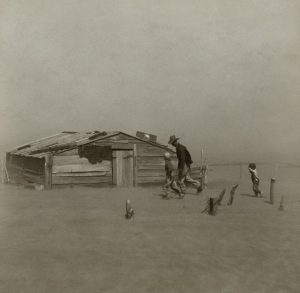10.5 Wind Erosion
In the early part of the 20th century, settlers dramatically expanded the area of cropland in the semi-arid western Great Plains. Encouraged by several years of favorable weather and commodity prices, these farmers plowed huge tracts of prairie to grow crops such as winter wheat. Herbicides were not available, so tillage was the primary means of weed control. Tillage was also considered by some to provide a means of reducing evaporative losses and conserving soil water. They reasoned that if a shallow surface layer of the soil was pulverized and desiccated by tillage, then the hydraulic conductivity of that layer would be so low, that soil water in the underlying layers would be protected from evaporation. This shallow, dry, pulverized layer of soil on the surface was sometimes referred to as a “dust mulch”, and it was effective in reducing evaporation in some cases. But, during the severe drought of the 1930s, these aggressive tillage practices made the land vulnerable to wind erosion on a massive scale.

Drought and poor land management practices combined to cause the “Dust Bowl” in the US Great Plains, a time of severe wind erosion. The devastation caused by this disaster is reflected in the iconic photograph from the Oklahoma Panhandle shown in Fig. 10‑6. Notice that the drifts of dust have buried large parts of the fence and the farm building, and the sky is filled with the same dust which is blowing in waves along the surface. This farm family appears to have no crops and no livestock remaining, and perhaps no hope. Due to drought, dust storms, and economic depression, millions of people packed up and moved out of the Great Plains states between 1930-1940, one of the largest migrations in US history. Although wind erosion in the US has not reached Dust Bowl levels since that time, severe dust storms have occurred in the Great Plains states as recently as 2012. Therefore, understanding and minimizing wind erosion is important still today.
As with water erosion, wind erosion includes three stages: detachment, transport, and deposition. Detachment typically occurs due to wind gusts that reach adequate velocity to separate particles from the soil surface. That is why management practices such as cover crops or standing crop residue can be effective preventive measures, since they reduce wind speed near the soil surface. Once particles are detached, they may be transported by processes such as:
- surface creep, i.e. rolling along the surface,
- saltation, i.e. bouncing along the surface, or
- suspension, i.e. being carried up and away from the surface for a substantial distance.
Deposition of windblown sediment is typically initiated by a decrease in the wind velocity, just as we saw for water-borne sediment. During the Dust Bowl barbed wire fences provided enough of a wind break to allow large drifts to form, so that in some cases livestock simply walked right over the top of the fence and wandered away. Sophisticated models have been developed to predict wind erosion processes, and one of the most widely-used models is the USDA Wind Erosion Prediction System (WEPS) [8].

